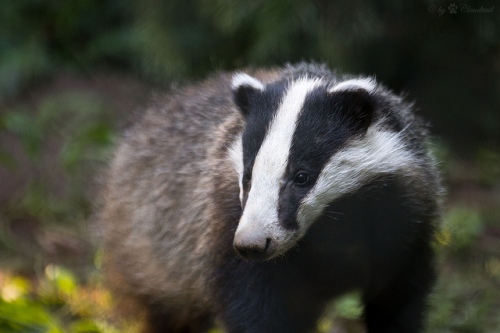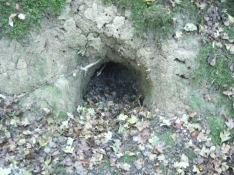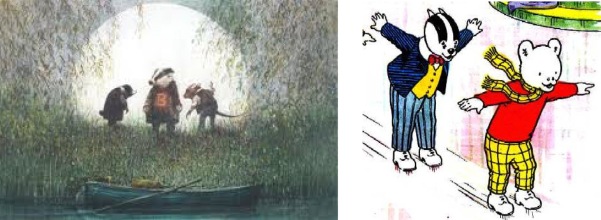Originally published November 2010
Hello everyone! The Winter nip is certainly in the air and the first of the icy nights have taken their toll on the more sensitive plants; their flaccid leaves drooping as if in resignation that their race has been run. Trees are magnificent in short-lived finery of copper, gold, and red and the odd sunny day sees a multitude of insects facing, what is for many of them, their swan song with fortitude.
Clearly our little Reserve is still full of life as the Gaelic festival of Samhain (October 31st) approaches to mark the beginning of the ‘darker half’ of the year and the start of the Celtic calendar. Perhaps the only animal that appears to cross the shadowlands between the light and dark is our very own Badger (Meles meles).

With the demise of bears and wolves in the UK, the badger has been our largest carnivore (excluding Homo sapiens!) for several centuries. Indeed, it is often referred to as Britain’s oldest landowner and the ancestors of our flourishing population in Crowhurst were marking their trails long before Britain became an island. I often think how this area must have looked a few thousand years ago. Amongst the ferns and moss-lined birch woods, the bear-like badger and its canine-like neighbour, the red fox, would have survived on a staple diet of earthworms supplemented with small rodents and birds. Rabbits were not seen on these shores until the 12th Century whilst grey squirrels are definite newcomers; introduced, along with many other foreign species, by those intrepid Victorians.
With its crepuscular (from the Latin crepusculum meaning twilight) tendencies and aposematic markings, warning potential predators that they are not to be tangled with, the venerable Brock is a creature of legend and wonder. Originally placed by our old friend Carolus Linnaeus (see Dec 2009) in the Family Ursidae, as he considered them to be a member of the bear clan, they are now part of the Mustellidae; that is to say related to weasels, stoats and otters et al. Despite being in the Order Carnivora, badgers are true omnivores and will eat cereal, fruit and vegetables alongside their favourite dish of worms! They are one of the few animals that can kill a hedgehog and the dearth of the prickly pigs in Crowhurst is almost certainly a consequence of several sets of those powerful badger jaws in action. Ma Nature (with the aid of some Darwinian logic) constructed those jaws for power and tenacity. Due to the lower mandible being connected to the upper by a transverse spur of bone called a condyle, which firmly locks into a cavity in the skull, it is impossible to dislocate the jaws. The resulting movement, controlled by facial muscles a denizen of Valhalla would have been proud of, ensures that the brocks bite is several times worse than its bark. The skull has a ridge of fused bone running along the top protecting the head from crushing attacks and there are recorded incidents of casualties having survived being hit by motor vehicles and even trains!
The name Badger is thought to have derived from the french word bechêur (to dig), introduced during The Conqueror’s reign. If this is the case they certainly live up to their name. The series of tunnels that make up badger setts (not to be confused with a cete, the collective noun for badgers) are extensive and seemingly well thought out. Centuries of digging by several sets of industrial-strength claws have created badger ‘cities’ throughout the south of Britain in areas of good drainage and readily available food.
 Numerous tell-tale signs indicate a lot of badger activity in Quarry Wood at the moment. Old bedding material is scattered around where it has been swept out of the distinctive D on-its-side shaped entrances to the setts. Shallow snuffle holes have appeared in several places where the animals have had to dig deeper for earthworms that are no longer coming to the surface to breed. Damp conditions are providing the perfect opportunity to hone those boy-scout tracking skills we all possess in our Robinson Crusoe or Last of the Mohican fantasy moments (surely I am not the only one who has these!). Badger spoor is distinguishable from that of other woodland animals by the presence of a large kidney-shaped pad and five digits topped by those long, bear-like (sorry Carolus!) claws.
Numerous tell-tale signs indicate a lot of badger activity in Quarry Wood at the moment. Old bedding material is scattered around where it has been swept out of the distinctive D on-its-side shaped entrances to the setts. Shallow snuffle holes have appeared in several places where the animals have had to dig deeper for earthworms that are no longer coming to the surface to breed. Damp conditions are providing the perfect opportunity to hone those boy-scout tracking skills we all possess in our Robinson Crusoe or Last of the Mohican fantasy moments (surely I am not the only one who has these!). Badger spoor is distinguishable from that of other woodland animals by the presence of a large kidney-shaped pad and five digits topped by those long, bear-like (sorry Carolus!) claws.
With a sense of smell 800 times stronger than our own, acute hearing and powerful frame this admirable ancient of the woodlands has only one enemy, us! We have vilified and terrorised badgers for centuries in the name of science, conflicts of territory and in ‘sport’ with the unspeakably mindless and abhorrent practise of ‘baiting’. Strangely our literature and folk-lore is littered with examples of this creature as a good and loyal, if slightly enigmatic, character; from Bill, friend of Rupert, and Badger, saviour of Toad, through to Trufflehunter, wise warrior of C. S. Lewis’s Chronicles. Only that mistress of anthropomorphism, Beatrix Potter, portrayed the badger in a bad light with Tommy Brock planning to cook a sackful of baby rabbits, hopefully after removing the jackets and mittens!

There is so much more to say about these delightful and fascinating animals that I am sure they will feature in the Tales again. For now I just take great pleasure in the fact that I share my neighbourhood with Brock and his family. Don’t forget the closest that many people around Britain will ever get to a badger is the traditional shaving brush!
I’m a beast, I am, and a Badger what’s more. We don’t change. We hold on…
Prince Caspian, C. S. Lewis (1951)
As always, any thoughts to pgcrow@yahoo.com
Paul Johnson
Image 1: Badger by Cloudtail, used under Creative Commons License 2.0